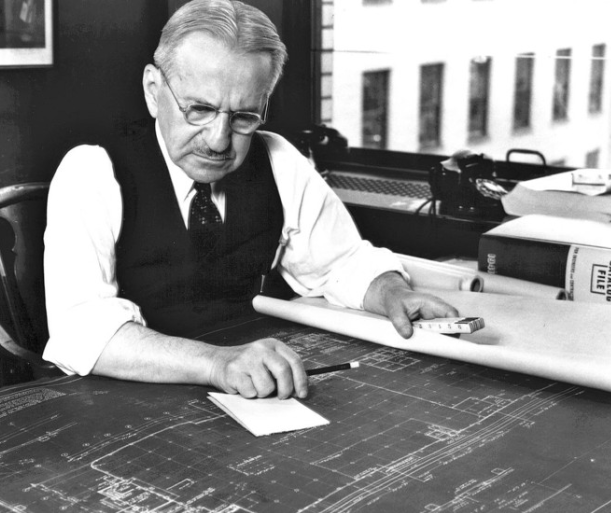Albert Kahn (1869-1942) was a renowned American industrial architect who revolutionized the design and construction of factories, offices, and other industrial buildings. Born in Rhaunen, Germany, Kahn immigrated to the United States with his family in 1880, settling in Detroit, Michigan. He studied architecture at the University of Michigan and started his career as an apprentice in several architectural firms in Detroit. In 1891, he joined the firm of Mason and Rice, where he worked on several notable buildings, including the Detroit Athletic Club.
In 1895, Kahn founded his own firm, Albert Kahn Associates, which would become one of the largest and most successful architecture firms in the world. Kahn’s designs were characterized by their functionality, simplicity, and efficiency. He was a pioneer in the use of reinforced concrete and steel-frame construction, which allowed for larger and more open spaces in industrial buildings. His designs also featured large windows, which provided natural light and ventilation, and allowed workers to see outside.
One of Kahn’s most notable contributions to industrial architecture was his work with the Ford Motor Company. In 1903, he designed the first Ford factory in Highland Park, Michigan, which was the first factory in the world to use a moving assembly line for mass production. This design revolutionized the automobile industry and made Ford the largest car manufacturer in the world. Kahn went on to design many more factories for Ford, including the massive River Rouge Complex, which was the largest industrial complex in the world at the time of its construction.
Kahn’s influence extended beyond the United States. He designed factories and other buildings in Europe, South America, and Asia. He also contributed to the design of the Soviet Union’s first industrial city, Magnitogorsk. Kahn was a proponent of internationalism and believed that architecture could help bring about world peace. He was a founding member of the International Congress of Modern Architecture and was awarded the Gold Medal of the Royal Institute of British Architects in 1931.
Kahn’s legacy can still be seen in the many buildings he designed, including the Detroit Institute of Arts, the Packard Motor Car Company Building, and the General Motors Technical Center. His influence can also be seen in the work of many contemporary architects who continue to use his principles of functionality, simplicity, and efficiency. Kahn died in 1942, but his contributions to industrial architecture and his belief in the power of architecture to bring about social change continue to inspire architects and designers around the world.


